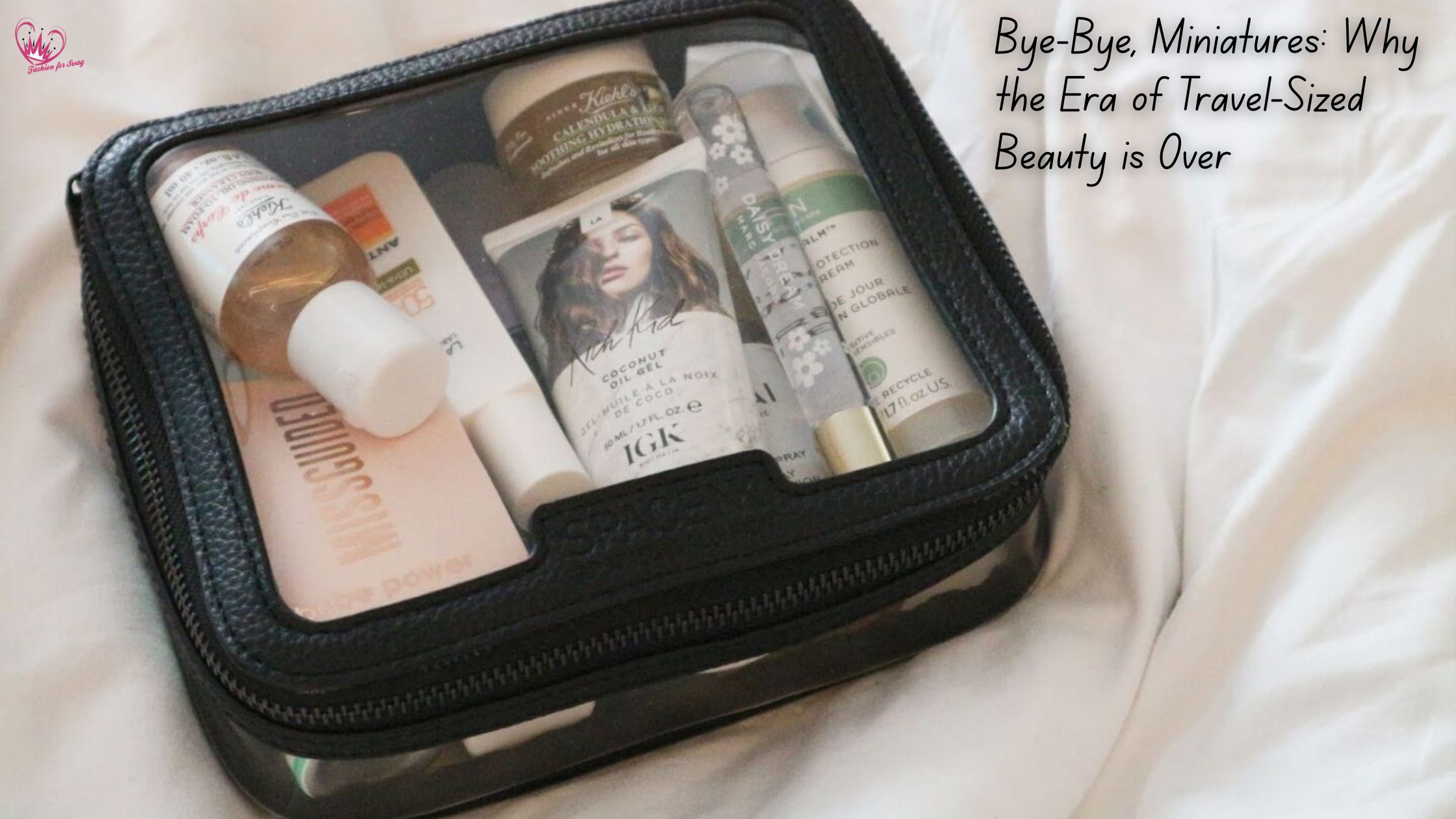
Bye-Bye, Miniatures: Why the Era of Travel-Sized Beauty is Over
The concept of the “miniature” or “travel-size” beauty product, once a staple of the retail landscape and a must-have for frequent travellers, is rapidly fading into obsolescence. The era where tiny shampoo bottles, tiny moisturizers, and snack-sized palettes reigned supreme in the travel segment is giving rise to a new paradigm in consumer behavior, driven by three powerful, interconnected forces: inexorable pressures for sustainability, a new focus on economic and functional efficiency, and the rise of consumer sophistication.
This is not a sudden death, but a gradual, deliberate shift away from a model that, upon closer examination, represents the opposite of modern, responsible consumption. The reasons are multifaceted, linking together environmental ethics, manufacturing economics, and lifestyle choices that have led to the end of the beauty mini.
1. The Unsustainable Footprint of the Miniature
The most important driving force behind the demise of the travel-sized beauty is global environmental consciousness and the urgent need to address plastic waste. Miniatures, by their very nature, are a packaging nightmare.
The Paradox of More Plastic
The primary problem lies in the unfavorable product-to-packaging ratio. A full-sized, 300ml shampoo bottle may use an amount of plastic proportional to its volume, but ten 30ml smaller bottles to hold the same total amount of product require ten different caps, ten different labels, and a disproportionately large amount of plastic overall. This leads to a rapid increase in packaging waste for temporary convenience.
Furthermore, small-sized plastics are often too small to be efficiently sorted by standard recycling machinery. Items under a certain dimension (usually less than two inches) are often filtered and sent to landfills, regardless of their material composition. This reality shatters the illusion of recyclability that can be printed on the packaging, turning the vast majority of these “convenient” bottles into single-use, non-recyclable waste. It is estimated that millions of mini-toiletries are purchased each year and subsequently thrown away, contributing significantly to global plastic pollution.
Industry-Wide Bans and Corporate Responsibility
The backlash against this waste has led to policy changes, particularly in the hospitality sector, which was a major provider of small toiletries. Major hotel chains and cruise lines, driven by both consumer pressure and legislative action (such as bans in various jurisdictions), are switching to bulk dispensers or larger, multi-use, refillable bottles. This industry-wide pivot has destroyed the primary distribution channel for bite-sized personal care items, removing them from millions of hotel bathrooms around the world and sending a clear signal to consumers about the unacceptability of single-use minis.
For the beauty brands themselves, continuing to mass-produce miniatures poses a significant headwind against their public-facing sustainability goals. Companies dedicated to the circular economy feel that the mini format is completely inconsistent with their commitment to reducing virgin plastic and promoting refillable alternatives.
2. The Rise of the Smart, Eco-Conscious Consumer
The modern beauty consumer is more informed, more selective, and more ethically motivated than ever before. This sophistication has fundamentally challenged the value proposition of the travel-size product.
Economic Inefficiency: Paying a Premium for Less
Consumers have become acutely aware of the “mini tax” – the fact that travel sizes often represent a dramatically worse value per ounce than their full-size counterparts. The price of a 50 ml mini-moisturizer can be 40% of the price of a 150 ml full-size version, meaning the customer is paying a substantial premium for the smaller quantity and packaging convenience. For a consumer focused on value and efficiency, this calculation no longer makes sense. The small savings on initial purchase are outweighed by the poor long-term cost-effectiveness.
The Power of Decanting and Refilling
The rise of refillable, reusable travel containers has proven to be the final consumer-driven nail in the coffin of the beauty mini. Today’s traveler is equipped with a stylish, durable, and leak-proof silicone tube and compact atomizer that allows them to dispense their true full-size favorites.
This simple action provides several benefits that miniatures cannot match:
- Brand loyalty and routine integrity: Consumers can maintain their established, trusted skin care and hair care routines without switching to a travel-sized version that may have a slightly different formulation or unproven track record.
- Zero Waste: By refilling a set of sustainable travel containers, the consumer completely eliminates single-use plastic waste.
- Precise quantity control: Passengers can measure the exact amount of product required for the duration of the journey, reducing wastage and ensuring they do not run out.
Cleaning is no longer seen as a chore, but as an integral part of preparing for sustainable, responsible travel – a small ritual that saves money and the planet.
3. Shifting Lifestyle and Product Formats
Changing travel habits, product innovation and the concept of “minimalist” routines have further reduced the need for liquid-based miniatures.
The Innovation of Solid and Concentrated Formulas
A quiet revolution in beauty has been the widespread adoption of solid and water-free beauty products. Shampoo bars, conditioner bars, solid cleansers and concentrated powder face washes do not all meet the requirement for TSA-compliant liquid containers.
These innovations provide:
- TSA Freedom: Solid products are exempt from the 3-1-1 rule for carry-on liquids, allowing significantly more product to be packed and eliminating the hassle of clear plastic bags.
- Improved Efficiency: Waterless formulas are more powerful, require less product per use, and are naturally lighter and more space-efficient.
- Near-zero packaging: Many solid bars come in minimal or fully compostable cardboard packaging, which aligns perfectly with sustainability goals.
The efficiency and environmental superiority of a solid shampoo bar over a small, liquid-filled plastic bottle makes the miniature format feel archaic.
The Realignment of the “Trial” Concept
In its early days, the Mini was marketed largely as a “trial size”, allowing consumers to test a high-end product before committing to the price of a full size. That function has been extensively absorbed and improved by the modern aesthetic landscape:
- Generous sampling: Brands often offer curated, free samples with online orders, allowing for true, no-commitment trials.
- Subscription Boxes: Monthly beauty boxes provide a steady stream of curated trial products, satisfying the desire to experiment without creating excess packaging waste on the go.
- Digital Research: The modern consumer relies on in-depth reviews, video tutorials and ingredient analysis to make purchasing decisions, reducing the need for physical test size.
In short, the role of the miniature as a gateway product has been made obsolete by more efficient and less wasteful marketing and sampling methods.
Conclusion: The New Travel Beauty Imperative
The departure of the travel-sized beauty era is a testament to the power of collective consumer action and technological innovation in the face of environmental challenge. The miniature, once a symbol of jet-setting luxury and convenience, has been exposed as a wasteful, unprofitable and unsustainable relic.
The modern imperative for beauty on the go is no longer about accepting a smaller, more expensive and ultimately disposable version of a product. It’s all about being intentional — investing in a set of durable, reusable decanting bottles, choosing solid or waterless formulas, and committing to a routine that’s both high-performance and low-impact. The future of travel beauty is not small; It is refillable, solid and durable.



